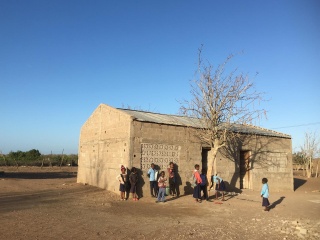
Why Mary's Meals is launching an emergency appeal for Southern Africa
Action is needed now to avoid a full-scale humanitarian disaster
Published onIt’s hard to comprehend how a weather event thousands of miles away can impact farmers in Southern Africa. But it does, and over recent months this impact has been catastrophic in the region, which is facing its worst drought in 100 years. Without major intervention, millions of people – especially children – will face “Crisis” levels of hunger (1).
Mary’s Meals is providing a lifeline to families in four of the worst-affected countries in the region. Read on to find out how the drought is impacting families in Malawi, Mozambique, Zambia and Zimbabwe – and how Mary’s Meals is bringing vital relief to families in these countries.
Drought is severely impacting food insecurity
The El Niño weather cycle, which can cause extremes of both drought and wet weather, has had a devastating effect on crop planting and harvesting across Southern Africa over the last three years.
In October 2024, a third successive seasonal planting window was disrupted by unusually high temperatures and lack of rain. For subsistence farmers working their own smallholdings, this has been catastrophic. Not only have their crops failed to thrive leaving little to harvest, but food has become scarce and more expensive.
Countries that have already declared drought disasters include Malawi, Zambia and Zimbabwe. Others in the region, including Mozambique where we recently established a school feeding programme, are also severely affected.

Roberto Mutisse from MSLI, our partner in Mozambique, explains: “It used to rain in September, and [families] would start preparing the land, clearing it and ploughing it. But now it doesn’t rain until maybe the end of December or January. If there is no water, then their crops and their cattle will die. The situation is really, really bad.
“That’s why having the school feeding programme is crucial because for a lot of children it is their only meal. When they go home after school, they don’t have anything for dinner.”
Extreme weather is creating food shortages
Angela Chipeta-Khonje is Country Director for Mary’s Meals in Malawi – where we feed more than one million children every school day. She explains why this current drought cycle is having such a serious impact.
She says: “Across Southern Africa, an estimated 21 million children are currently malnourished (2). Disruptive weather patterns, including extreme temperatures, unprecedented drought and flash flooding, are felt deeply in this region because there are so many smallholder farmers relying on rain-fed agriculture for their survival.”
“Here in Malawi, we are seeing acute need across the regions where we work. We know that families have very little to get them through to the next harvest, and we anticipate the 2025 harvest will be very lean.
“The Mary’s Meals school feeding model – feeding children in their place of education every school day – helps to support families in these difficult times through the assurance of a nutritious meal for their child or children, making limited family rations stretch further.”
The risk of a full-scale humanitarian disaster
In Zambia, the drought situation is causing widespread disruption. Mary’s Meals’ Country Director Panji Kajani says: “In Zambia, like much of Southern Africa, we rely heavily on hydroelectricity. With river levels low and reservoirs at less than a third of their capacity, we are all subject to electricity rationing.”
“This affects everyone from small businesses and large industrial operations to individual families in towns who have to rely on generators, pushing up the price of fuel and causing shortages."
“For rural communities, the impact is even more acute. We know of many families who would usually harvest 20 bags of maize from their plot, who have just five bags to last their family until the next harvest.
“Knowing that some of their children will receive a meal at school makes the difference between that grain running out in January or lasting until March.”
Help us feed more children across Southern Africa
Our school meals bring hope. They encourage children into the classroom and give them energy to learn. This means, even in this most difficult of times, these children can make the most of their education and help break the generational cycle of poverty.
Mary’s Meals CEO and Founder, Magnus MacFarlane-Barrow, says: “We need to expand school feeding as fast as possible into areas of acute need across Malawi, Zambia, Zimbabwe and Mozambique. Our programme is owned by and embedded in local communities, equipping them to provide vital school meals for their children in an effective and sustainable way. We know school feeding works and we know our programme is scalable. With your urgent help, we can work quickly to reach many thousands more vulnerable children with much-needed meals while they learn.”
We are currently reaching 1.5 million children in Southern Africa with our nutritious school meals. But there is more we can do. We need your help to bring more children back from the brink of desperation.
It costs just 10p a day to feed a child with Mary’s Meals. With your support we can help many thousands more children and families through this devastating drought. Please donate today.


